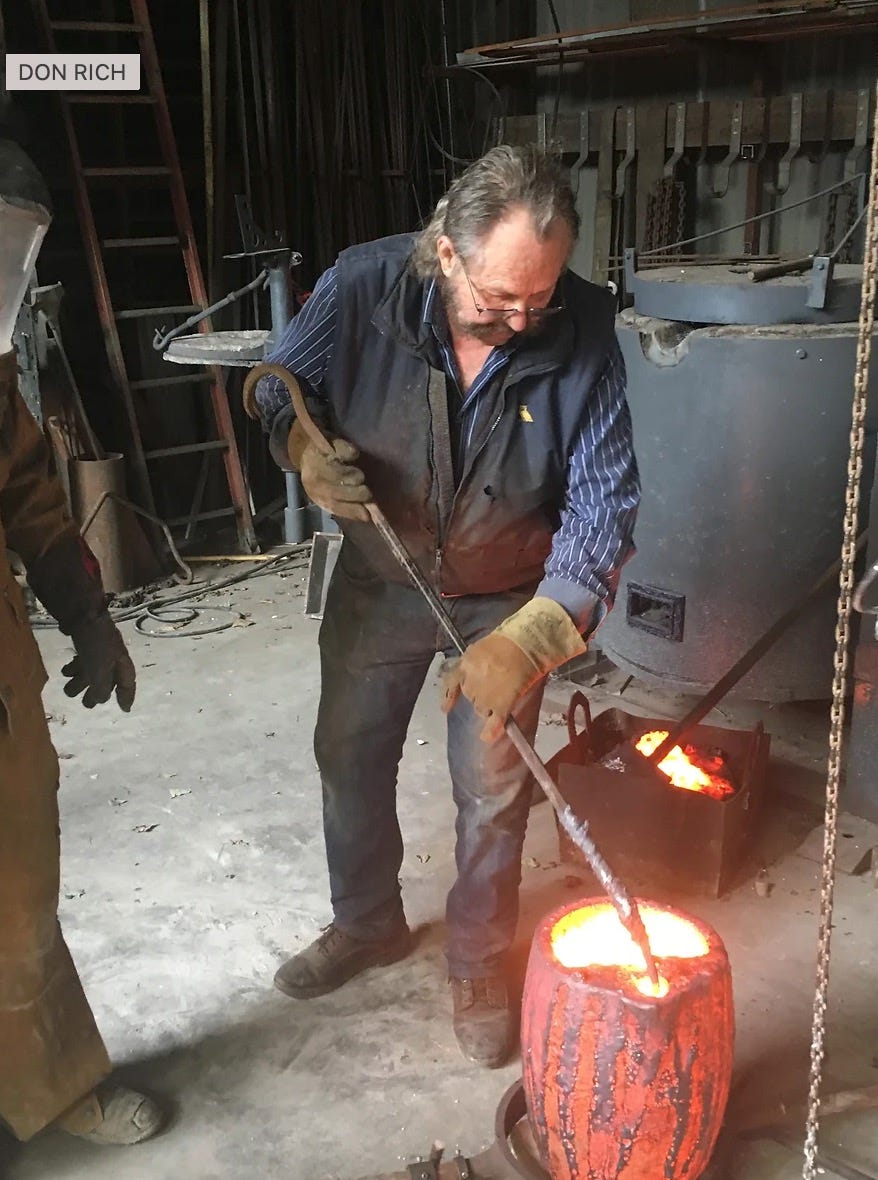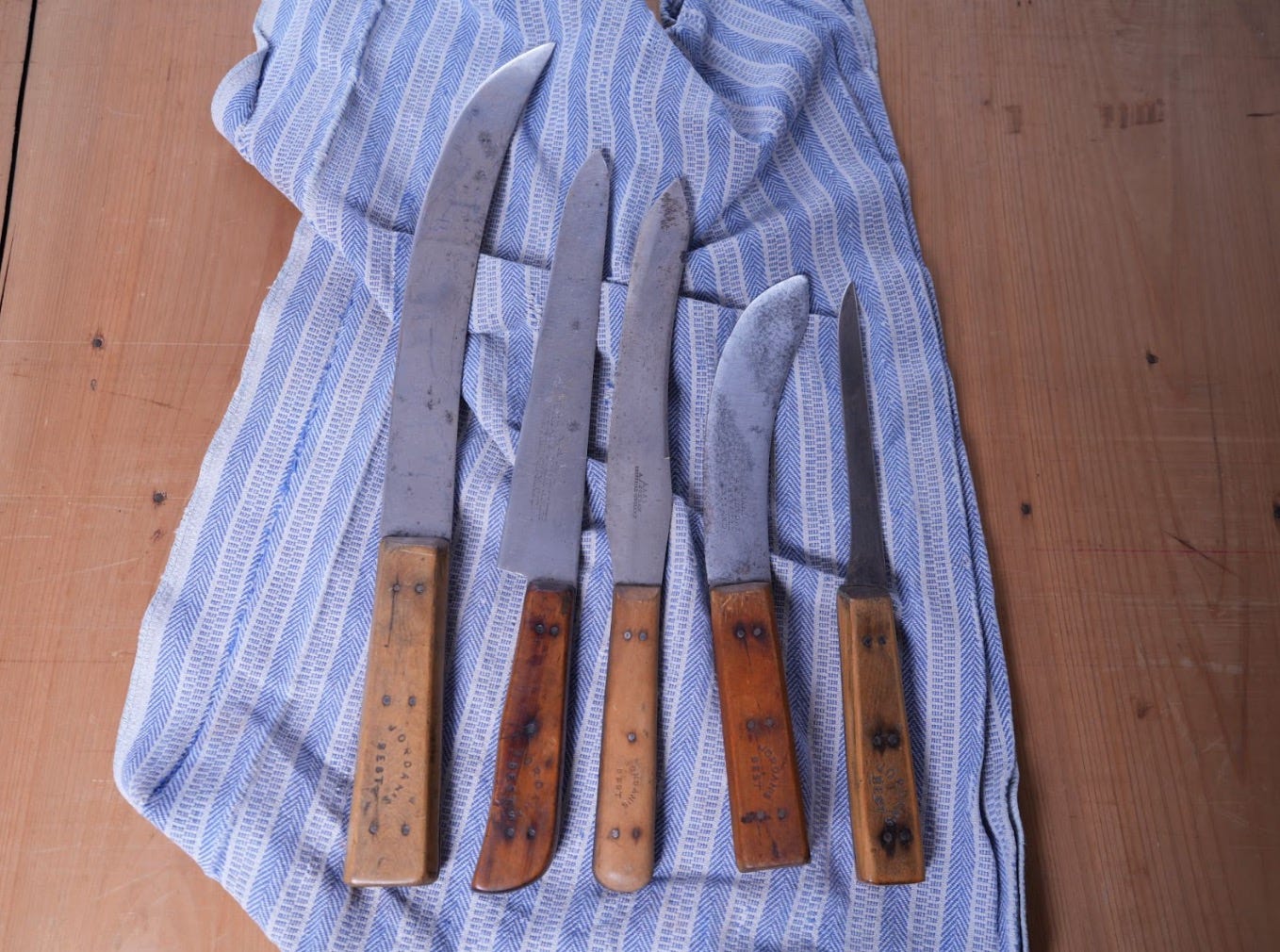The 9 Lives of Old Knives: An Incredible Old Collection and New Projects
What story does a life-time of collecting knives tell? by Josh Donald
The idea to do a second book has been simmering for years, but that pot was set to a boil with the chance acquisition of a lifetime’s worth of collection from local sculptor and culinary knife collector Don Rich who passed away last year. He had a bronze foundry in Oakland where he did his own bronze sculpture and commissions and had a New Year’s Day party with an obscene amount of pies made ahead of time for his friends. Still documented on his website here.
I met Don over musty boxes of knives in the flashlight-lit pre-dawn hours of Bay Area flea markets. Our initial begrudging acknowledgment of each other through the lens of flea market etiquette (don’t dart your hands into this box of old knives until I’m done looking, please) morphed into a friendly rivalry that led to geeking out about knife history and trading old knives with each other. Don’s once omnivorous collection had begun to become more specific to several makers, and as I would find them, we would trade for the ones that had become ancillary to Don’s focus.
Don collected a lot of carving sets and tableware, among the chef knives, butcher knives, and other miscellany. The carving sets and some tableware had gone out of fashion as people’s lives and attitudes towards formal meals had changed a lot in the 75, 100 or 175 years ago when these were made. Old things carry a story and especially so culinary knives and tableware; it’s essentially impossible to tease out the stories of how these ended up separated from their previous owners, but it’s hard not to imagine the stories ranging everywhere from family drama and estrangements to the benign neglect of simply not appreciating old stuff.
Many of the pieces show a good amount of wear, which can sometimes hint at the personalities of the old owners. Old tableware in particular, from those with slender means, bears the wear of their owner’s eating style and carry a particular feeling. Is it possible for a fork to be haunted? From carving sets and tableware to common household kitchen knives to finer professional quality knives, they all bore witness to an often lost and sometimes very familiar world of food that they are the markers of.
Rather than parcel them all off right away (even though there are some I would be excited to add to the shop), I felt that this collection helped define a story that I had been finding about the story that knives tell, both from an individual level to the much larger socio-political one.
Don focused his collection of knives on the J. Russell Green River Works of Greenfield and Turners Falls, Massachusetts, A. J. Jordan from Sheffield, England, and Will & Finck and Michael Price from 19th century San Francisco. A through line of these makers (aside from being nearly 3000 miles apart from each other respectively) is the Industrial Revolution’s reverberations from its epicenter in the UK through its evolution in New England out to the then-new city of San Francisco. I’ll get into these makers more in the future as their stories link up excitingly here but here’s a quick introduction on the three.
The Don Rich Collection and His Writing
I am immensely grateful to have been contacted by Don’s family about his knives and hope he’d be happy about that too. Hopefully, I can help organize some of what he was putting together in his collection and hopefully pick up some bits of information that I wasn’t able to get from him during our knife trades or during slow moments at the flea market when we would show each other our day's finds. Don had done some writing about steel that is pretty interesting and that I will share in later installments that link up with some other elements of the story.
For those interested in Don, here’s his website. You’ll be able to guess that it is not current, but there’s more information about him and his work there, so, check it out.
Stay tuned for more entries to our Substack newsletter. Kelly and I will talk about our new and old projects, reflect on running a knife shop, and discuss the behind-the-scenes. We also have some big announcements coming soon, including a new book project we’re working on (no title yet). We’ll also be sharing our recent and upcoming knife and food travels here.
Will & Finck + Michael Price (SAN FRANCISCO)
Will & Finck and Michael Price were both post-gold rush San Francisco knife makers who made many items. Before the transcontinental railroad came out west, all sorts of goods had to come via boat around South America or made in California. The local pride in the goods made in San Francisco was high, and these two knifemaking works were definitely warranted. Despite being of a very high quality, these San Francisco-made knives were made in a unique style that, once discovered by the larger outfits back east, became quickly imitated, granted at a different level of quality. The fighting knives from these makers have long commanded huge prices, but the culinary knives, primarily carving sets, are typically very affordable and might wash up on the island of lost knives here in the Bay Area and beyond.
A.J. Jordan
A. J. Jordan, interestingly, was an American who moved to Sheffield to set up a business making unique culinary knives at a time when Sheffield’s reach into the American cutlery market had taken a bit of a nosedive post US civil war. While still one of the world’s most important cutlery manufacturing centers Sheffield had been broadsided in the US by strict tariffs and the growth of the American cutlery industry that was more eager to include mechanized techniques to improve output. A.J. Jordan leaned on Sheffield’s highly skilled hand-made cutlery techniques utilizing some of Sheffield’s best knife-making steel; double-shear steel with a handle of ultra-durable Persian boxwood to make very unique and super high-quality knives for professional chefs and butchers. These knives presage a lot of current knife making sensibilities, thin blades, and ergonomic handles. Weird shapes. A J Jordan also resold a lot of other Sheffield-made knives with his brand on them (not made with Persian boxwood and double-shear steel), but the ones made by the A J Jordan company are really phenomenal.
J. Russell Green River Works
J. Russell held a special interest for Don; it’s hard not to appreciate their knives if you are into finding old cutlery, the width and breadth of what they made in the 19th century is quite large, but I suspect there were larger motifs that caught his attention. J. Russell Green River Works is arguably the first American cutlery operation formed in the nascent economic and material independence from Great Britain. Their story outlines the birth of American industry in New England and summarizes many of the important facets of 19th-century American history, warts and all.










Loved this! Hey Don told me that before the Industrial Revolution, silver never needed to be polished, because the air was cleaner and it didn’t tarnish.
LOTS of memories here Josh! For me, it is an honor to have known Don and to have learned from him. His collection is truly WORLD CLASS and I am proud to have contributed to it over many years.